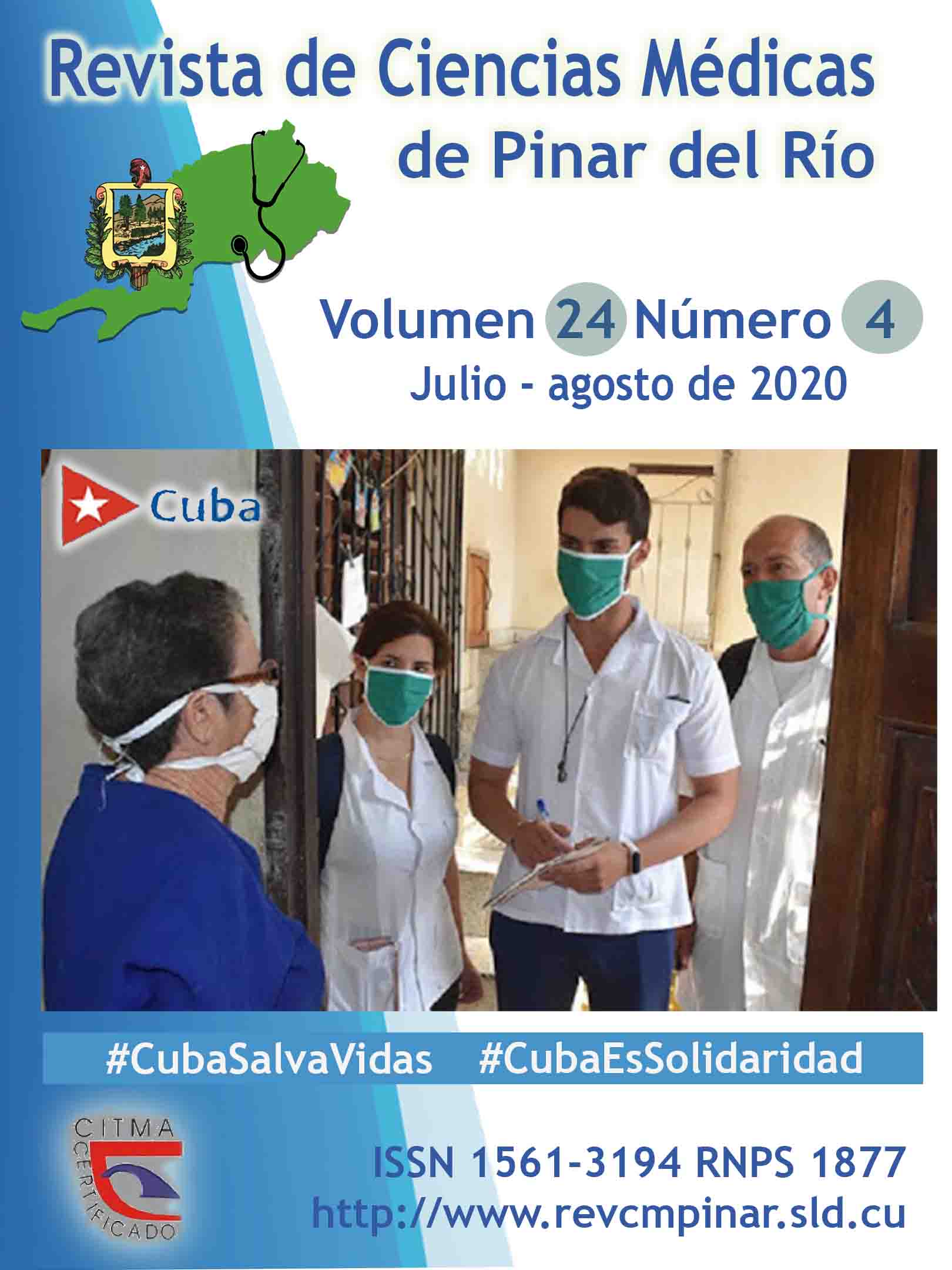Behavior of the process of registration at Pinar del Rio university of Medical Sciences
Keywords:
EDUCATION, HIGHER, PUBLIC HEALTH, STUDENTS, MEDICAL.Abstract
Introduction: since the beginning of the triumph of Revolution in Cuba, one of the most important projects has been promoted, where the family and the school have trained the young generations to study a university degree.
Objective: to describe the registration process in the period 2016-2019 in medicine major at Pinar del Rio university of Medical Sciences.
Methods: a descriptive and retrospective study was carried out applying theoretical methods: analysis-synthesis, induction-deduction and historical-logical, which alloweddeepening in the theoretical referents of the topic with its progressive advances; and empirical: documentary examination and interview to key informers.
Results: the process of registration in medicine major was not systemic because it revealed inadequate correlation between the enrollments of twelve level of education with the planning of places to the major of medicine, throughout the periodanalyzed.
Conclusions: the theoretical analysis carried out revealed that the process of registration during the period 2026-2019 in medicine major at Pinar del Rio University of Medical Scienceswas not systemic. Itshowed inadequate correlation between the enrollment of twelve level of education, with the places planned to register higher education, as a way to continue the studies and instruction processes of men and women in their life span.
Downloads
References
1. Cuba. Ministerio de Justicia. Decreto Ley No. 67 de 19 de abril de 1983, de Organización de la Administración Central del Estado. Artículo 8, inciso d) Cuba. 1983, Ministerio de Justicia. p. 4-8
2. Cuba. Ministerio de Salud Pública. Resolución no. 146 de 1998. Ciudad de la Habana: MINSAP; 1998. p 2
3. MES. PROCESO DE INGRESO A LA EDUCACIÓN SUPERIOR 2019 [Internet]. Ministerio de Educación Superior; 2019. [citado 13/3/2020]. Disponible en: https://www.mes.gob.cu/es/noticias/proceso-de-ingreso-la-educacion-superior-2019
4. Lineamientos de la Política Económica y Social del Partido y la Revolución; 2011
5. Solernou Mesa IA, Martí Brenes M, Leal Mursuli A, Padilla Docal B. Experiencia formativa en investigación desde el preuniversitario. Educ Med Super [Internet]. 2005 [citado 13/03/2020]; 19(3). Disponible en: http://bvs.sld.cu/revistas/ems/vol19_3_05/ems05305.htm
6. Sánchez Vignaul B. La universalización de la educación superior en Cuba: una oportunidad para reflexionar sobre los modelos de gestión en las bibliotecas universitarias. VI Taller de Bibliotecas Universitarias de Iberoamérica y I Encuentro Nacional de Bibliotecas Universitarias. ACIMED [Internet] 2003 [citado 13/03/2020]; 12(2). Disponible en: http://scielo.sld.cu/pdf/aci/v12n2/aci13204.pdf
7. Amaro Cano MC, Fernández Hernández A, Lescaille Taquechel M, Santiago Garrido A. Curso preparatorio al ingreso de la universidad de ciencias médicas o premédico. La Habana: UCM; 2011.
8. Fernández Oliva B, Morales Suárez I, Portal Pineda J. Sistema de influencias para la formación integral de los egresados en los centros de educación médica superior. Educ Med Super [Internet]. 2004 [citado 29/02/2012]; 18(2): [aprox. 12p.]. Disponible en: http://bvs.sld.cu/revistas//ems/vol18_2_04/ems02204.htm
9. Moreno Lazo M, Alonso Pérez S, González Corrales S, Rodríguez Fontes R. Comportamiento del otorgamiento de las carreras de enfermería y tecnología de la salud. Rev Ciencias Médicas [Internet]. oct.-nov. 2007 [citado 29/02/2012]; 11(4). Disponible en: http://scielo.sld.cu/scielo.php?script=sci_arttext&pid=S1561-31942007000400022
10. Velázquez García L, Alfonso Gonzalez Y, Valverde Bravo I, Vilaú Díaz LA. Orientación profesional desde la Universidad hacia las carreras de Enseñanza Técnico Profesional. Rev Ciencias Médicas [Internet]. 2018 [citado 03/01/2018]; 22(1): [aprox. 12p.] Disponible en: http://revcmpinar.sld.cu/index.php/publicaciones/article/view/3423
11. Fernández B, Soler C, Rodríguez R, Soler SF. Diseño y aplicación del Test de Habilidades Múltiples en el proceso selectivo de ingreso al destacamento Carlos J. Finlay. Educ Med Super [Internet]. Mar 2004 [citado 01/02/2019]; 18(1): [aprox. 1p.]. Disponible en: http://scielo.sld.cu/scielo.php?script=sci_arttext&pid=S0864-21412004000100004&lng=es
12. Pérez Obregón BR, García Cedeño YC, Nuez Hernández M, Betancourt Rodríguez I, Menéndez Pérez M, Alcántara Paisán F. Propuesta de textos para orientar profesionalmente a los estudiantes diferidos del grupo de ciencias médicas. EDUMECENTRO [Internet]. 2012 [citado 15/01/2019]; 4(3): [aprox. 12p.]. Disponible en: http://scielo.sld.cu/scielo.php?script=sci_arttext&pid=S2077-28742012000300017
Downloads
Published
How to Cite
Issue
Section
License
Authors who have publications with this journal agree to the following terms: Authors will retain their copyrights and grant the journal the right of first publication of their work, which will be publication of their work, which will be simultaneously subject to the Creative Commons Attribution License (CC-BY-NC 4.0) that allows third parties to share the work as long as its author and first publication in this journal are indicated.
Authors may adopt other non-exclusive license agreements for distribution of the published version of the work (e.g.: deposit it in an institutional telematic archive or publish it in a volume). Likewise, and according to the recommendations of the Medical Sciences Editorial (ECIMED), authors must declare in each article their contribution according to the CRediT taxonomy (contributor roles). This taxonomy includes 14 roles, which can be used to represent the tasks typically performed by contributors in scientific academic production. It should be consulted in monograph) whenever initial publication in this journal is indicated. Authors are allowed and encouraged to disseminate their work through the Internet (e.g., in institutional telematic archives or on their web page) before and during the submission process, which may produce interesting exchanges and increase citations of the published work. (See The effect of open access). https://casrai.org/credit/



